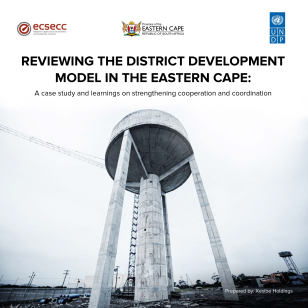Reviewing the District Development Model (DDM) in the Eastern Cape
Reviewing the District Development Model (DDM) in the Eastern Cape
July 6, 2023
The democratic era was then an opportunity to create a unitary state, with wall to wall boundaries, albeit with a quasi-federal character that devolved functions and powers to subnational spheres of government. The South African Constitution of 1996, committed the new country to national, provincial, and local spheres of government, brought together in a governance framework that would be ‘distinctive, interdependent and interrelated’. Under this framework, local government would not be a sphere subordinate to the interests or a function of national and provincial spheres, but rather an integral component of the democratic state in its own right.
While theoretically a way to manage the balance in negotiation between unitary and more federalist notions of what the new society should be; in practice, this approach has created an environment where there has been a ‘pattern of operating in silos’, which has given rise to incoherence in planning and implementation, which has made monitoring and oversight of government programmes difficult.
Initiated by President Cyril Ramaphosa in 2019, the District Development Model (DDM) emerged in recognition of these weak coordination outcomes and institutional incapacity. The DDM is a practical intergovernmental mechanism that brings together the forty-four (44) districts and eight (8) metros across the country, as ‘developmental zones’ built around the strategic alignment of all three spheres of government to guide strategic investments and projects.
Our study emerges from this focus and considers the early development of the DDM as a practical IGR mechanism and describes and analyses the planning and coordination system in the Eastern Cape, considering the draft One Plans developed by Districts in the Province.
In undertaking the study, we drew on a combination of methods, which included secondary data analysis, reviews of the Draft Plans, primary research interviews with officials in the Districts, the provincial and national sphere and a public survey administered online. Furthermore, the study considered the international experiences of long-term planning in subnational spheres of government in China, Malaysia, and Uganda. Significant lessons arise from these experiences. Critical among these is the need for clear role distribution between different spheres, the need for an interface between technocratic, implementing, and political layers of authority and the critical role of crowding in non-transfer resources, by intentional design of implementation commitments rather than as a coincidence of planning.
The analysis also considered the alignment between the diagnostic, vision, mission and strategy-setting actions, and the implementation framework of earmarked activities and projects. This considered how the Plans were developed, where these Plans drew on existing planning instruments and whether implementation areas identified were in alignment with the envisaged end-state, or the economic, social, and spatial change sought.
Moreover, the study found a few critical insights worth mentioning. Firstly, the identification of ‘catalytic’ projects is drawn from the discretion of officials rather than any strategic framework. The outcome is a ‘grocery list’ of planned, ongoing, and envisaged projects, with no visceral link to the change sought. We propose in this study, a framework that considers projects whose activities and impact span across geographical and spatial boundaries, projects that advance universal access to basic social and economic services, those that secure current and future bulk service requirements and ultimately, those that enable economic and spatial transformation and equity.
Secondly, our case study focused on OR Tambo, found that while some of the catalytic projects can ‘catalyze’ economic and spatial transformations that enable the development of tourism and agriculture-related economic activities and enable social reproductive activities, the One Plan overlooks the significant task of stabilizing the governance and financial management environment in the local and District authorities in the District. Furthermore, from an infrastructure and service delivery perspective, a constrained macro-fiscal environment means that the local authorities will need to consider non-transfer means of financing their ambitious pipeline of projects. This will require significant improvement in project scoping and packaging, to crowd in non-state actors to overcome the funding gaps associated with many planned capital investment projects.
Thirdly, for the above to happen, there is a need for clear signalling and information systems approaches, which strengthen the Centralized Data Management and Analytical System (CDAS), developed by the DPME in a way that allows for the aggregation of geospatial, financial and other project-level data across the 52 IGR impact zones that can give a meaningful ‘birds-eye’ image of what these projects mean for the broader spatial theory of change as encompassed in the National Spatial Development Framework and how this informs ongoing revision and iteration of the National Development Plan.
For more, download the report.

 Locations
Locations





